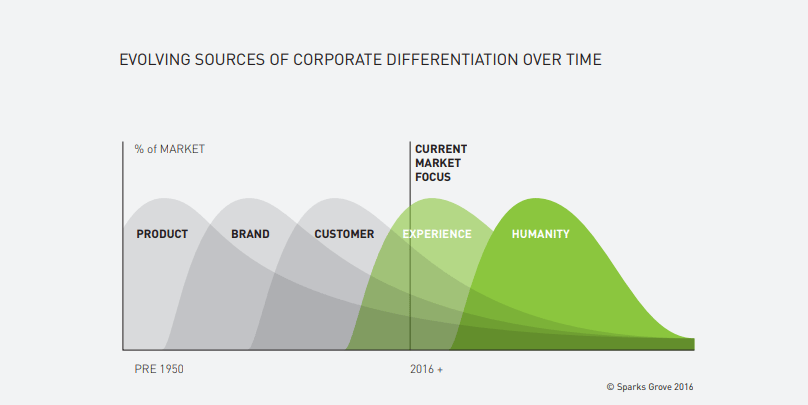The potential of the future depends on our experiences as humans 🔮
You may or may not have seen, nowadays companies are investing heavily in technologies to improve their employee and customer experiences, designed for allowing for greater access to all. Also of note, there has been a significant rise in investments in social initiatives to address issues of income and gender disparity.
It’s critical for businesses to consider the impact of technology on people who use it and seek ways to better support everyone, not just the few. To be effective, technology must be combined with ESG (environmental, social, and governance) commitments to enable the change we need to occur.
This report from ExperienceFuture.org examines the rise of Human Experience (HX) in digital business and its potential to shape social impact. I plan on unpacking it.
- Companies are investing more in digital products and services, but have not adequately addressed the needs of diverse users.
- To truly develop a social impact program that checks every box from sustainability to diversity, equity, and inclusion to corporate citizenship, leaders must prioritize human needs in their digital transformation efforts.
- This requires integrating sustainability, inclusion, and social agendas into digital product and service design.
- Technology adoption alone does not generate financial benefits or positive social impact; it is their ability to use that technology that will help them achieve their primary objective.

Organizations can align business and social goals with digital offerings by engaging in Human-Centered Design (HCD) approaches and frameworks. By obtaining data and insights from their users and understanding their individual needs, organizations can create complete prototypes and clear implementation plans that connect the digital experience to individual needs. Additionally, organizations should prioritize adoption of human experience to ensure sustainability of their social impact goals. This will give employees, customers, and investors a reason to choose the organization over their competitors.
Organizations should also integrate sustainability, inclusion, and social agendas into digital product and service design in order to close the gap in corporate social impact programs. Technology and software industries have undergone a radical shift in recent decades, resulting in a higher standard of expectation for user experiences. By considering the needs, abilities, and challenges of all individuals who use their systems, organizations can create solutions that are not only advanced but also readily acceptable.
Furthermore, organizations should prioritize employee well-being when it comes to digital transformation. By aligning their business to human needs and experiences and executing with authenticity and empathy, they can foster empowerment, engagement, and happiness within their workforce. This will augment key performance indicators (KPIs) such as net promoter scores (NPS), as well as create more effective internal processes such as sales and HR.
Organizations can align business and social goals with digital offerings by engaging in HCD approaches and frameworks that consider the individual needs of users.

Integrate Sustainability, Inclusion, and Social Agendas Into Design
Integrating sustainability, inclusion, and social agendas into design is essential for organizations in order to create a successful social impact program. Blending these agendas into design requires organizations to take into account the needs, abilities, and challenges of all individuals who use their systems. This involves considering the different types of users when creating digital products, as well as making sure their designs are accessible and inclusive for all. Organizations should also consider how their products can positively impact the environment and society, by promoting equitable growth and providing transparent information. Additionally, organizations should aim to create delightful experiences that foster customer loyalty and employee engagement. By incorporating these agendas into design, organizations will be able to create a holistic human experience that meets the needs of their customers, employees, and investors while also creating positive social impact.
Prioritize Human Needs in Digital Transformation

Businesses can prioritize human needs in digital transformation by investing in research to understand user needs and preferences, utilizing Human-Centered Design approaches and frameworks, adopting agile processes to quickly deploy solutions, and integrating sustainability, inclusion, and social agendas into a digital product and service design. Still, there is much more research required for gaining insight into essential user needs and preferences. Companies could create new opportunities and touchpoints through a myriad of options and techniques, such as surveys, interviews, focus groups, and online analytics to gather data. The insights found from the data can be used to improve the design process.
Incorporating Human-Centered Design into digital transformation is essential to address the escalating needs of people. HCD provides complete prototypes and clear implementation plans that connect the digital experience to individual needs. Companies must also adopt agile processes to quickly deploy solutions and make necessary changes based on user feedback. It just makes sense that organizations should integrate sustainability, inclusion, and social agendas into a digital product and service design to ensure equality for all users. No brainer.
Technology Benefits Companies Financially and Socially
Companies can gain financially and socially from technology adoption. It can help lower costs of traditional activities, like labor-intensive administrative tasks, via automation. Technology can improve customer experience, which leads to increased loyalty, repeat sales, and increased revenues.
Technology can help create positive change in society. For example, it can provide wider access to education, health services, and critical resources to decrease poverty and discrepancies in wealth. Companies incorporating technology-backed strategies often reinvest their resources to focus on social issues related to their objectives. This not only benefits society but also helps build positive relationships with customers and employees who are likely to trust these companies more when they show commitment to social causes.
Technology adoption can be beneficial for businesses: cost-efficient automation, improved customer service, and support for social causes matching their values and mission.

Integrating ESG & DEI with Tech Adoption
Integrating ESG and DEI with tech adoption can have numerous benefits for businesses, including financial gain and social impact. ESG programs can help businesses attract investors, build customer loyalty, improve financial performance, and make operations sustainable1,2 . By integrating ESG standards, companies can also benefit from more sustainable business practices and improved risk management2 . Additionally, technology companies are being analyzed and rated based on ESG criteria, making it crucial for them to adopt ESG practices3 . Furthermore, the re-platforming to cloud-native technology can bring benefits such as speed, agility, collaboration, and governance4 . Integrating DEI with tech adoption can also lead to a more diverse and inclusive workforce, which can improve innovation and decision-making5 .
Firstly, companies that prioritize ESG and DEI are seen as more ethical and reliable from an investor’s perspective. This can lead to increased investment in the company and potential partnerships with other organizations. Additionally, having a strong ESG and DEI framework in place can lead to improved customer satisfaction. Customers are increasingly expecting companies to not only offer quality products or services but also to address important social issues. By integrating ESG and DEI into tech adoption, companies can better serve their customers’ needs while helping to create a more equitable society. Furthermore, ESG and DEI initiatives may help to attract top talent who are looking for organizations that prioritize these ideals. Finally, integrating ESG and DEI into tech adoption can help to reduce inequality within the company itself. Organizations can ensure equitable treatment by providing all employees with uniform access to resources, regardless of gender, race, or socio-economic status.
Token Wisdom
The key takeaway from this paper is that organizations must prioritize the adoption of Human Experience (HX) in order to achieve sustainable social impact goals, create equitable growth, and deliver delightful experiences to customers and employees. Organizations must integrate digital products and design into their social impact programs to ensure their long-term sustainability and ensure that technology adoption is combined with ESG and DEI commitments for maximum effectiveness. Let’s hope that while we’re designing these Human Experiences for humans we don’t forget about experiencing the experience itself which allows for a holistic approach and a much better perspective to narrow down from.




Member discussion